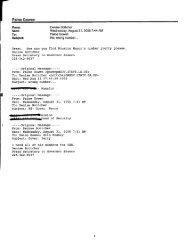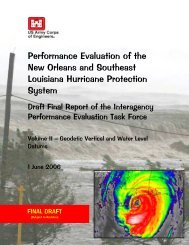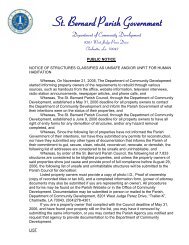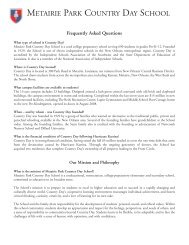IPET Report 3 Vol VIII
IPET Report 3 Vol VIII
IPET Report 3 Vol VIII
You also want an ePaper? Increase the reach of your titles
YUMPU automatically turns print PDFs into web optimized ePapers that Google loves.
Failure and Overtopping Probability. Failure probabilities including overtopping probability<br />
was computed based on a performance function as commonly used in structural reliability<br />
assessment (see for example Ayyub 2003; Ayyub and McCuen 2003) as given by<br />
Z = R− L<br />
(3)<br />
Where Z = performance function, R = strength (resistance) and L = loading in the structure. In<br />
this case the resistance is provided by the hurricane protection elevation, and the loading is<br />
provided by the surge/wave elevation. The non-performance probability was computed as<br />
P= Prob ( g < 0)<br />
(4)<br />
Once the total volume was obtained from all overtopping and breach cases, the net volume<br />
(as a random variable) needed for consequence analysis was computed by adding water volume<br />
from rainfall, and the effect of pumping that includes backflow. The pumping volume and<br />
backflow are considered as a multiplier called the pumping factor.<br />
Illustrations. Table 4 provides typical results for a reach. Several hypothetical reaches were<br />
used to construct overtopping results that were aggregated by subbasins as illustrated in Table 5.<br />
In this example, the basin is assumed to contain one or more subbasins. The overtopping results<br />
for this subbasin include the overtopping volume based on an overtopping condition and the<br />
overtopping probability was computed using system reliability concept.<br />
Water <strong>Vol</strong>umes from Other Features of the Protection System. The hurricane protection<br />
system includes other features that could allow water volume to enter the protected areas during<br />
a hurricane. These features include:<br />
1. closure structures, i.e., gates, that are left open or failed to close<br />
2. localized changes in levee or floodwall elevations that create a transition in the HPS<br />
These features are identified within each reach and assigned to subbasins in case of nonperformance.<br />
For the closure structures case, the water volume resulting from failure of the<br />
closure structure for a given hurricane was computed based on respective gate closing failure<br />
probabilities, width of the closure structure and elevation of the bottom of the structure. The<br />
water volume associated with the localized changes in levee or floodwall elevations requires<br />
identification of the changes in elevation and the lengths over which the elevation varies. Table 5<br />
shows a tabulated structure for computing volumes associated with features.<br />
<strong>Vol</strong>ume <strong>VIII</strong> Engineering and Operational Risk and Reliability Analysis <strong>VIII</strong>-21<br />
This is a preliminary report subject to revision; it does not contain final conclusions of the United States Army Corps of Engineers.













